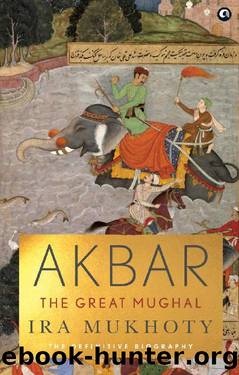Akbar: The Great Mughal by Ira Mukhoty

Author:Ira Mukhoty [Mukhoty, Ira]
Language: eng
Format: epub
Publisher: Aleph Book Company
Published: 2020-04-01T19:00:00+00:00
*Two hundred lengths of the ten-foot rod made up a kos.
†Hobson-Jobson’s Glossary lists the Akbari kos as measuring 2m. 4 f. 183 1/3 yards.
*A biographical memoir.
THE LION OF GOD
The scale of the Nauroz celebrations that took place in Fatehpur Sikri over eighteen days in March 1582 was unprecedented. More than a decade after construction had begun, Fatehpur Sikri was ablaze in its final resplendence. In the golden spring light of March, all the buildings of the palace city glowed—the red sandstone of Sikri, also the royal crimson colour of Kshatriyas—the colour of kings. Within an encircling wall more than 11 kilometres in length, a series of interlocking palaces and courtyards lay along the ridge overlooking the city—a harmonious ensemble of monumental spaces and small, intimate ones. Some of the largest buildings included the main assembly hall, the diwan-e-aam, a large, majestic courtyard with 114 cloistered bays and a raised central pavilion. At the other end of the ridge was the largest gateway ever built in the country at the time, the Buland Darwaza, over 130 feet high, and vaulting even higher due to an additional flight of 123 steps leading from the street below. This majestic gateway led to an immense Jami Masjid, the first of the congregational mosques of the Mughals, built to accommodate 10,000 worshippers. In the middle of the immense courtyard of the mosque was the jewel-like tomb of Salim Chishti, plastered white. Between these two structures were connecting buildings in unusual styles, including the five-floored Panch Mahal topped with a domed chattri, the Anuptalao with its rectangular pond, and the diwane-khas, with its utterly mesmerizing massive sculptured column, supporting a stone throne platform.
The diwan-e-aam and the diwan-e-khas were decorated with wall hangings of gold and silk, European curtains, paintings, and high tents. The bazaars of Fatehpur Sikri and Agra were similarly ablaze with bunting and cloth and ‘the Emperor sent for all sorts of troops of singers and musicians, both Hindu and Persian, and dancers, both men and women, by thousands of thousands’. Akbar sat on a golden throne, wearing a crown, and called on all the people to celebrate, to ‘show their joy either by leaping, singing or dancing’. Hindustan was a land of clamorous and varied celebrations and there were ‘actors, dancers, singers, players of instruments, mime artistes, rope dancers, jugglers, tap dancers, troubadours and ganikas’. A particularly appreciated entertainment was afforded by the Bahurupi, whose performance included startlingly accurate mimicry of people and animals. ‘Youths disguised themselves as old men so successfully,’ marvelled Abu’l Fazl, ‘that they impose upon the most acute observers.’ All those who presented themselves were given gifts, wine, and a banquet of food and, not surprisingly, throngs of people jostled to view the extravagant affair and ‘whole communities of jogis arrived, with their chiefs’. Monserrate was astonished to note that these jogis ‘profanely and frivolously laid aside all pretense of piety, danced impudently and shamelessly, and fulsomely flattered the King in the songs they sang’. Women were allowed into
Download
This site does not store any files on its server. We only index and link to content provided by other sites. Please contact the content providers to delete copyright contents if any and email us, we'll remove relevant links or contents immediately.
| Africa | Americas |
| Arctic & Antarctica | Asia |
| Australia & Oceania | Europe |
| Middle East | Russia |
| United States | World |
| Ancient Civilizations | Military |
| Historical Study & Educational Resources |
Wabi sabi by Kempton Beth(721)
Mr. Selden's Map of China by Timothy Brook(601)
Heroic Hindu Resistance To Muslim Invaders (636 AD to 1206 AD) by Sita Ram Goel(573)
Akbar: The Great Mughal by Ira Mukhoty(542)
The Meaning of India by Raja Rao(537)
Vedic Physics: Scientific Origin of Hinduism by Raja Ram Mohan Roy(535)
Banaras by Diana L. Eck(526)
Philippines--Culture Smart! by Culture Smart!(503)
Mao's Great Famine: The History of China's Most Devastating Catastrophe, 1958-1962 by Frank Dikötter(500)
Food of India by unknow(496)
China Unbound by Joanna Chiu(486)
How to Be a Modern Samurai by Antony Cummins(473)
India--Culture Smart! by Becky Stephen(473)
A History of Japan by R.H.P. Mason & J.G. Caiger(468)
Insurgency and Counterinsurgency by Jeremy Black(465)
North of South by Shiva Naipaul(461)
The Genius of China: 3,000 Years of Science, Discovery, and Invention by Robert Temple(446)
Kim Jong Un and the Bomb by Ankit Panda(431)
The Digital Silk Road by Jonathan E. Hillman(423)
